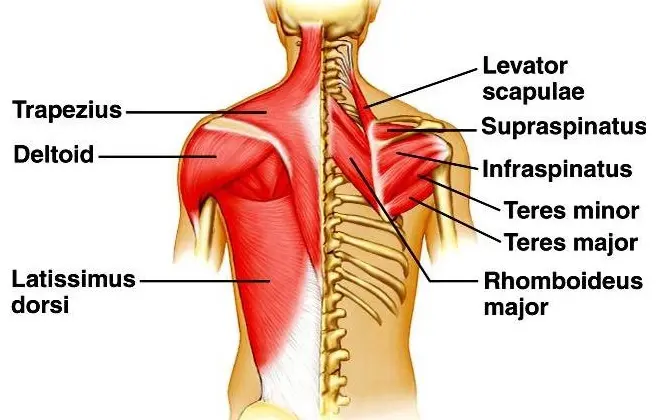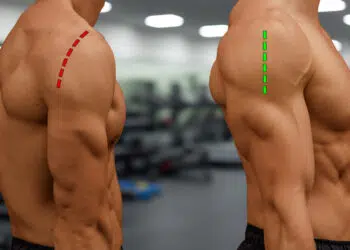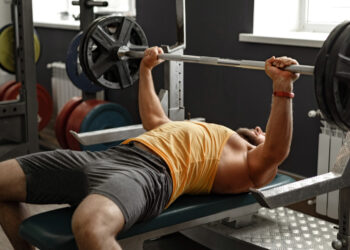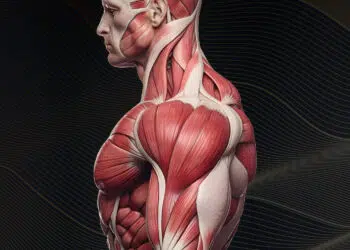While your knees would probably disagree, your shoulders are arguably the hardest working joints in your body. You can’t train your pecs, lats, or delts without using your shoulders, and some arm and lower body exercises involve your shoulders too.
That’s why shoulder pain can be so debilitating. Painful, creaky shoulders can make almost everything except riding a stationary bike uncomfortable, unpleasant, or even impossible.
That’s why good shoulder health is so important. As lifters, we NEED to look after our shoulders so that they do not become a liability.
One way to keep your shoulders in good shape is to ensure that you train all three deltoid heads (anterior, medial, and posterior) equally and also strengthen the underlying rotator cuff muscles. It also pays to keep your mid and lower traps in good shape.
One way to do this is to add the cable Y raise to your shoulder workouts.
In this article, we reveal why and how to do this excellent exercise, as well as the seven best alternatives and variations.
Level Up Your Fitness: Join our 💪 strong community in Fitness Volt Newsletter. Get daily inspiration, expert-backed workouts, nutrition tips, the latest in strength sports, and the support you need to reach your goals. Subscribe for free!
Cable Y Raise – Muscles Worked

Technically, cable Y raises are an isolation exercise, meaning that they involve movement at a single joint. However, unlike many isolation exercises, the cable Y raise involves several different muscle groups as the joint action is actually quite complex.
The main muscles affected by cable Y raises are:
Deltoids – the deltoids are your largest shoulder muscles. There are three sections of fibers, called heads, that make up the deltoids…
- Anterior (front)
- Medial (middle)
- Posterior (rear)
Cable Y raises work all three deltoid heads, making them a very time-efficient shoulder exercise.
Trapezius – known as the traps for short, this is the large diamond-shaped muscle of your upper back. Like the deltoids, there are three sections that make up the trapezius…
- Upper
- Middle
- Lower
All three sets of trapezius fibers are involved in cable Y raises. However, the lower and middle traps work the hardest.
Rhomboids– working with the mid-traps, the rhomboids help pull your shoulders back and together. They’re located between your scapulae or shoulder blades. The rhomboids are an important postural muscle.
Rotator cuff – located underneath the deltoids, the rotator cuff is the collective name for the supraspinatus, infraspinatus, teres minor, and subscapularis muscles. These muscles are responsible for stabilizing your shoulder joint and controlling some of the more minor shoulder joint movements.
Serratus anterior – shaped like a serrated saw blade, the serratus anterior holds your scapulae flat against your rib cage. It’s located on the side of your upper ribs, just above your obliques. The serratus anterior is also known as the boxer’s muscle.
How to Do Cable Y Raises
Get more from cable Y raises while keeping your risk of injury to a minimum by following these guidelines:
- Attach D-shaped handles to the low pulleys on a cable crossover machine. Stand between the pulleys and hold each handle in the opposite hand. Step back to tension the cables and so that they cross in front of your hips.
- Alternatively, as per the video, you can forgo the handles and grip the cables themselves.
- Stand with your feet shoulder-width apart, brace your abs, and ensure that your elbows are slightly bent but rigid.
- Raise your arms outward and upwards until they’re above your head and form a Y-shape.
- Lower your arms back to the starting position and repeat for the desired number of reps.
- This exercise works best when done with light to moderate weights and medium to high reps.
Cable Y Raise Benefits and Drawbacks
Not sure whether cable Y raises are the right exercise for you? Consider these benefits and then make up your mind.
A very time-efficient exercise
Cable Y raises work all three deltoid heads as well as your upper, middle, and lower traps, serratus anterior, and rotator cuff. As such, they cover a lot of muscles in one straightforward exercise. They’re the ideal deltoid exercise if you are short of time but still want a comprehensive shoulder workout.
Improve your posture
Posture is the alignment of your joints, and it can be good or bad. Prolonged sitting and doing too much chest training can lead to rounded shoulders and a hunched upper back. Cable Y raises work the muscles responsible for maintaining good posture.
Healthier shoulders
Shoulder pain is a common problem for many lifters. In a lot of cases, should pain is caused by a weak rotator cuff, poor posture, and/or overdeveloped anterior deltoids. Cable Y raises can help prevent and fix these issues, reducing the likelihood of developing and severity of existing shoulder pain. It’s also a very shoulder-friendly exercise.
Cable Y Raise Drawbacks
While cable Y raises are a mostly beneficial shoulder and upper back exercise, there are also a couple of drawbacks to consider:
Equipment
If you train in a commercial gym, you probably have everything you need to do this exercise, such as a cable crossover or a functional cable machine. However, home exercisers are less likely to have the necessary equipment to do cable Y raises. That said, it can be done using resistance bands, and there are free-weight and bodyweight alternatives you can do instead, which we’ve detailed below.
Not really a mass builder
While you’ll undoubtedly feel this exercise working your shoulders, it’s more of a general conditioning exercise than an out-and-out mass builder. As such, it’s probably best done as a supplement to and not a replacement for things like overhead presses and lateral raises.
Level Up Your Fitness: Join our 💪 strong community in Fitness Volt Newsletter. Get daily inspiration, expert-backed workouts, nutrition tips, the latest in strength sports, and the support you need to reach your goals. Subscribe for free!
7 Cable Y Raise Variations and Alternatives
Cable Y raises are a highly effective exercise, but that doesn’t mean you need to do it all the time. There are several variations and alternatives you can use to keep your workouts productive and interesting:
1. Cuban press
The Cuban press was supposedly invented by Cuban weightlifters looking for an efficient way to improve shoulder mobility and strength. It was subsequently popularized by legendary Canadian strength coach Charles Poliquin.
Like cable Y raises, the Cuban press also works all three deltoid heads as well as your upper and lower traps. However, the Cuban press may be more accessible for home exercisers because it’s traditionally done using just a barbell.
How to do it:
- Hold a barbell with an overhand, shoulder-width grip. Stand with your feet shoulder-width apart, knees slightly bent, and core tight.
- Starting with your arms straight, row the barbell up to your lower chest. Your elbows should be higher than your hands.
- Next, rotate the barbell forward and up to your forehead.
- Press the weight overhead and then reverse this action to return to the starting position.
- Cuban presses can also be done using dumbbells or a cable machine.
2. Victory dumbbell raise
No cable machine? No problem! You can still work the same muscles as cable Y raises with nothing more than a pair of light dumbbells and a short resistance band called a mini band. This is an excellent pre-hab shoulder exercise and also delivers an awesome joint-friendly deltoid workout for all three heads.
How to do it:
- Place your resistance band around your wrists, so you look like you’re wearing handcuffs. Hold a dumbbell in each hand and stand with your feet roughly shoulder-width apart, knees slightly bent, and core braced.
- Starting with the dumbbells in front of your hips, hands facing inward, raise your arms forward and out to form a V shape above your head.
- Lower your arms but do not let the dumbbells come too close together. Instead, keep some tension on the band even at the bottom of each rep.
3. Face pulls
Like cable Y raises, face pulls work your deltoids and your traps at the same time. However, face pulls involve a horizontal rowing action and, as such, only really target the posterior deltoids and middle trapezius.
This means that face pulls are an excellent postural exercise but aren’t as comprehensive as cable Y raises. Still, they’re a very worthwhile exercise and are a great antidote to all those bench presses you’re probably doing and all the time you spend hunched over your computer.
You can read all about face pulls here.
4. Incline prone dumbbell press
While every pressing exercise hits your anterior and medial deltoids, there are very few that emphasize your rear deltoids, traps, and rhomboids. In fact, this unusual exercise is probably the only one.
So, if you are looking to work your shoulders from an entirely new angle and want to use presses to do it, this is the exercise for you! Take care not to go too heavy with this one; it’s a lot harder than it looks.
How to do it:
- Set an exercise bench to about 45-60 degrees and hold a dumbbell in each hand. Lie face down on the bench with your head uppermost.
- Raise the dumbbells up to the front of your shoulders. Pull your shoulders down and back and brace your core.
- Press the dumbbells forward and up, keeping them in line with the rest of your body.
- Return to the starting position and repeat.
5. Cable shoulder press
While not as rear delt and lower-trap centric as cable Y raises, this exercise is still more than a simple overhead pressing exercise. Using a single cable means you’ll need to push the handle up AND back, which works your delts and upper back simultaneously. This is a very joint-friendly overhead pressing variation and an excellent alternative to barbell and dumbbell overhead presses.
How to do it:
- Attach a straight bar to a low cable. Grip the handle with an overhand, slightly wider than shoulder-width grip. Curl or clean the handle up to your shoulders.
- Brace your core, pull your shoulders down and back, and stand with your feet roughly shoulder-width apart.
- Press the handle up and overhead to arms’ length. Push the handle backward as well as up.
- Lower the bar back to your shoulders and repeat.
6. YTI dumbbell shoulder complex
A complex is a sequence of exercises done back-to-back using the same training implement and usually for the same number of reps. This YTI dumbbell complex is designed to hit your deltoids and traps from several angles simultaneously.
This is a good freeweight alternative to cable Y raises. Still, it is a little less time-efficient because it involves three movements instead of just one. This exercise is best done using light weights so you can perform each movement without using momentum to lift your dumbbells.
How to do it:
- Set an exercise bench to about 45-60 degrees and hold a dumbbell in each hand. Lie face down on the bench with your head uppermost. Let your arms hang down from your shoulders, palms turned inward.
- Raise your arms forward and out to form a Y shape. Then lower your arms and repeat for the desired number of reps.
- Next, lift your arms out to the side to form a T shape. Then lower your arms and repeat for the desired number of reps.
- Finally, raise your arms backward so the dumbbells travel back to your hips. Lower your arms and repeat for the desired number of reps.
7. Scapular wall slides
Scapular wall slides, also known as wall angels, are a surprisingly tough rhomboid, middle trapezius, and posterior deltoid exercise. Instead of working your muscles with weights, for this movement, you’ll be working against the tension generated by your pecs.
The tighter your pecs are, the harder you’ll find this exercise. So, as well as working your upper back, scapular wall slides also provide your chest with a useful stretch. Scapular wall slides are an excellent postural exercise. If your posture needs work, do this exercise every day.
How to do it:
- Stand with your back against a smooth wall. Your feet should be slightly in front of your hips, knees bent for stability.
- Raise your arms and, with your elbows bent to 90 degrees, press them against the wall. Your upper arms should be parallel to the floor. Press your lower back into the wall.
- From this position and keeping your arms and the backs of your hands against the wall, slide your hands upward. Reach up as far as you can while maintaining the pressure against the wall.
- Slide your hands back down and repeat.
- If you find this exercise too hard, do it while lying on the floor instead.
Cable Y Raises – Wrapping Up
To the uninitiated, cable Y raises look a little like cable lateral raises poorly done. However, they’re actually a really effective exercise with plenty of benefits. For starters, they work all three deltoid heads, as well as your upper, middle, and lower traps. They’re also good for strengthening your rotator cuff, potentially warding off shoulder aches and pains.
So, if you’re looking for a time-efficient shoulder exercise that’s also good for your posture and joint health, the cable Y raise would make a valuable addition to your workout library.
Interested in measuring your progress? Check out our strength standards for Bench Press, Face Pull, Cable Lateral Raise, and more.








